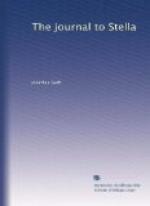12 Thomas Yalden, D.D., (1671-1736), Addison’s college friend, succeeded Atterbury as preacher of Bridewell Hospital in 1713. In 1723 he was arrested on suspicion of being involved in the Atterbury plot.
13 Tablets.
14 Sir Solomon de Medina, a Jew, was knighted in 1700.
15 Davenant had been said to be the writer of papers which Swift contributed to the Examiner.
16 Henry Withers, a friend of “Duke” Disney (see Letter 16, note 20), was appointed Lieutenant-General in 1707, and Major-General in 1712. On his death in 1729 he was buried in Westminster Abbey.
17 See Letter 36, note 18.
18 Dyer’s News Letter, the favourite reading of Sir Roger de Coverley (Spectator, No. 127), was the work of John Dyer, a Jacobite journalist. In the Tatler (No. 18) Addison says that Dyer was “justly looked upon by all the fox-hunters in the nation as the greatest statesman our country has produced.” Lord Chief-Justice Holt referred to the News Letter as “a little scandalous paper of a scandalous author” (Howell’s State Trials, xiv. 1150).
Letter 40.
1 Dr. John Sharp, made Archbishop of York in 1691, was called by Swift “the harmless tool of others’ hate.” Swift believed that Sharp, owing to his dislike of The Tale of a Tub, assisted in preventing the bishopric of Hereford being offered to him. Sharp was an excellent preacher, with a taste for both poetry and science.
2 An edition of the Countess d’Aulnoy’s Les Contes des Fees appeared in 1710, in four volumes.
3 Francis Godolphin, Viscount Rialton, the eldest son of Sidney, Earl of Godolphin, succeeded his father as second Earl on Sept. 15, 1712. He held 3 various offices, including that of Lord Privy Seal (1735-1740), and died in 1766, aged eighty-eight. He married, in 1698, Lady Henrietta Churchill, who afterwards was Duchess of Marlborough in her own right. She died in 1733.
4 See Letter 26, note 24. Ladies of the bed-chamber received 1000 pounds a year.
5 William O’Brien, third Earl of Inchiquin, succeeded his father in 1691, and died in 1719.
6 Lady Catherine Hyde was an unmarried daughter of Laurence Hyde, first Earl of Rochester (see Letter 8, note 22). Notwithstanding Swift’s express statement that the lady to whom he here refers was the late Earl’s daughter, and the allusion to her sister, Lady Dalkeith, in Letter 60, note 26, she has been confused by previous editors with her niece, Lady Catherine Hyde (see Letter 26, note 24), daughter of the second Earl, and afterwards Duchess of Queensberry. That lady, not long afterwards to be celebrated by Prior, was a child under twelve when Swift wrote.
7 Sir John Trevor (1637-1717), formerly Speaker of the House of Commons.
8 See Letter 11, note 44.
9 See Letter 34, note 10.
10 See Letter 23, note 2.




